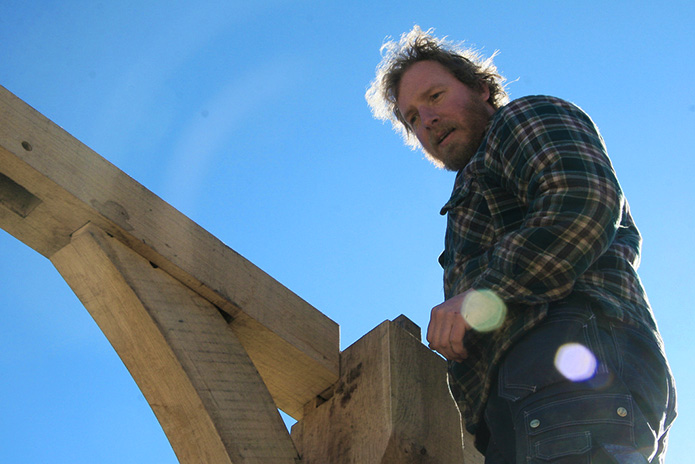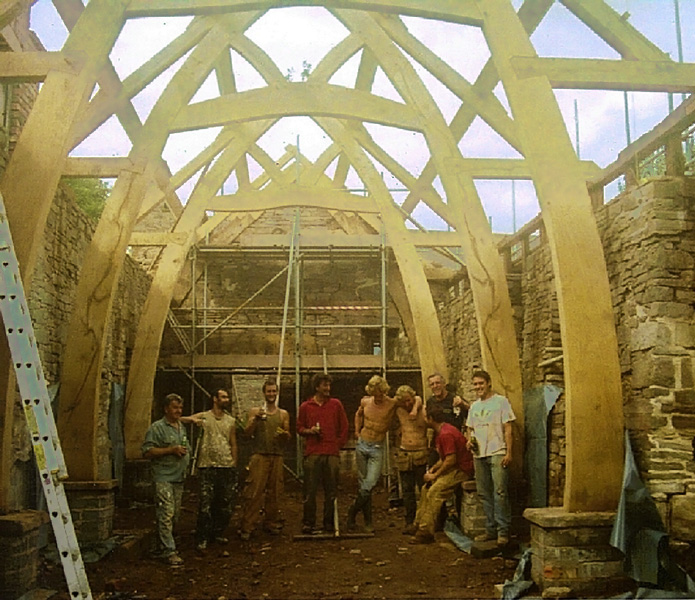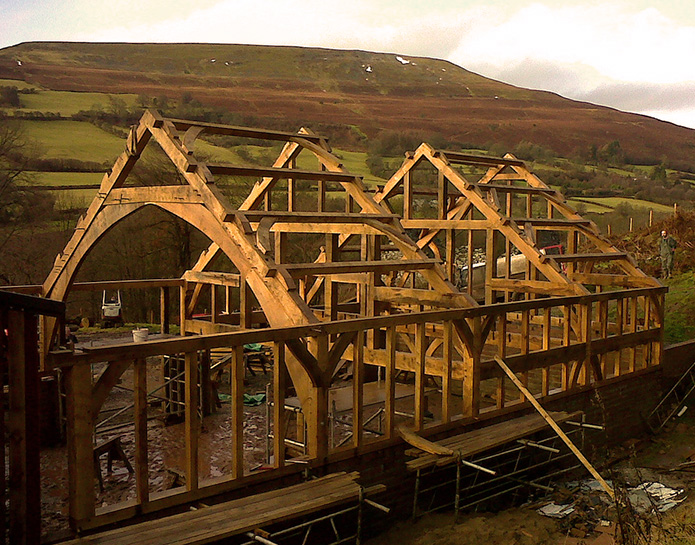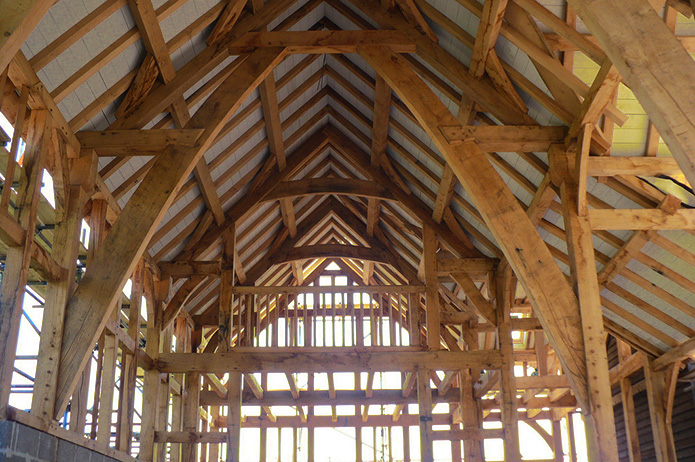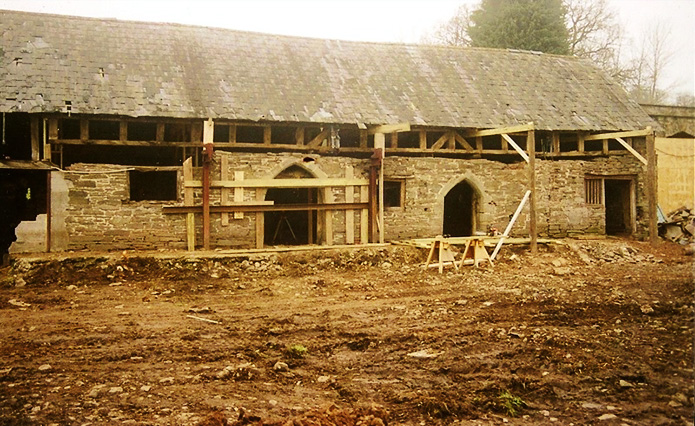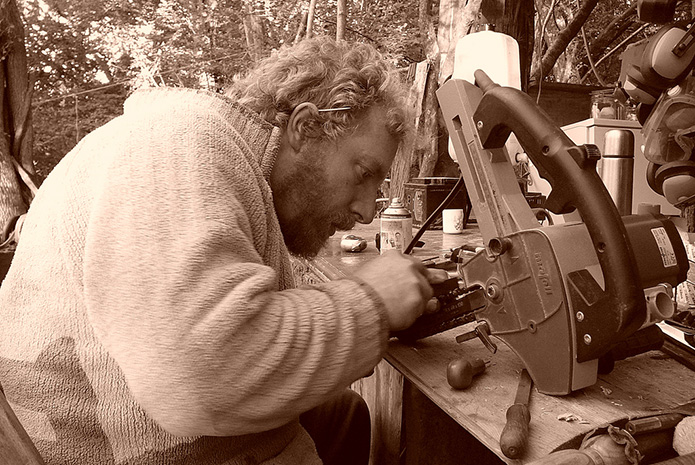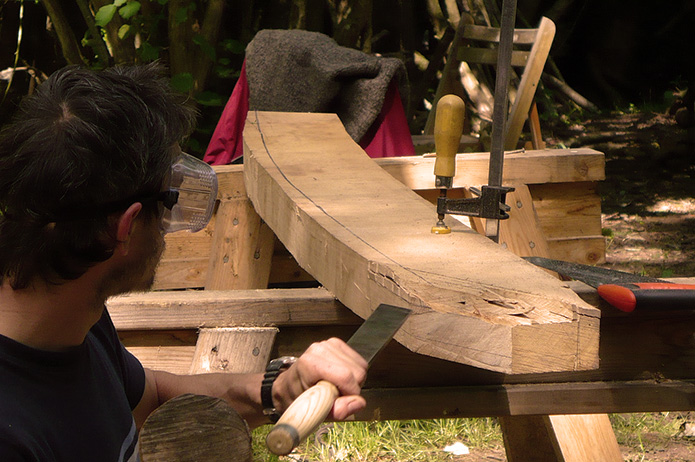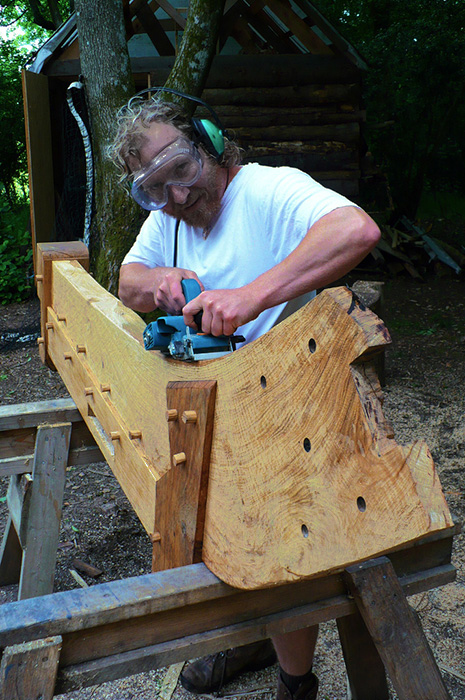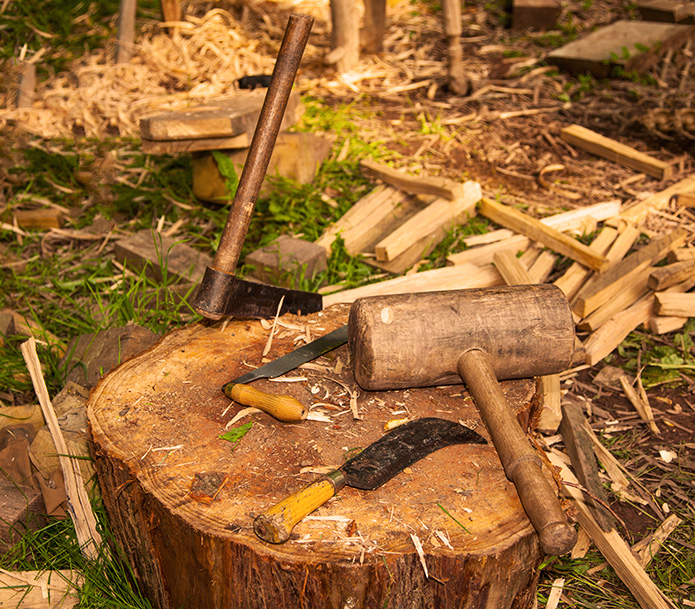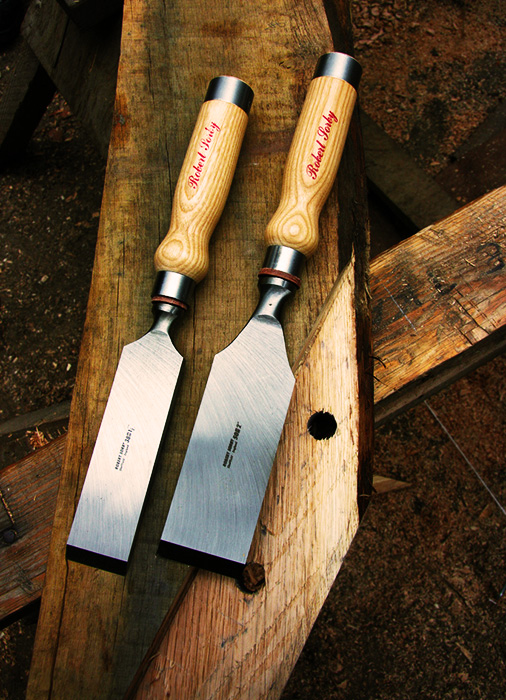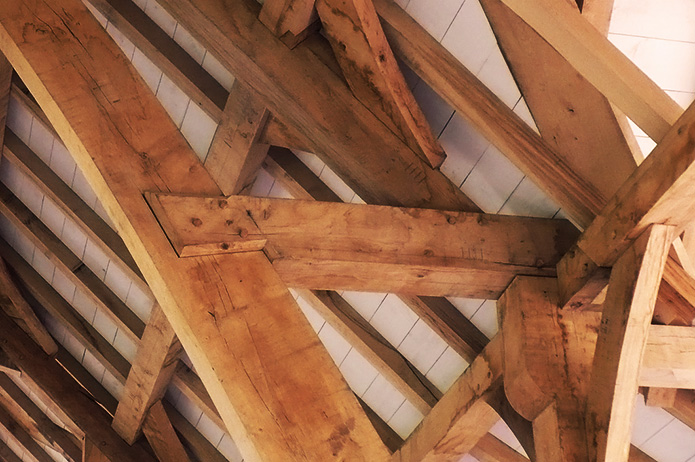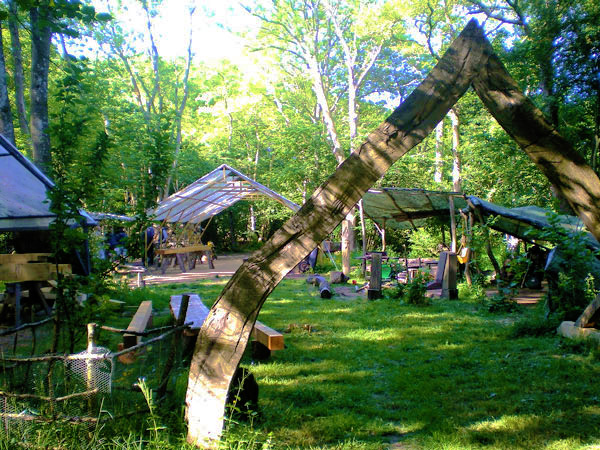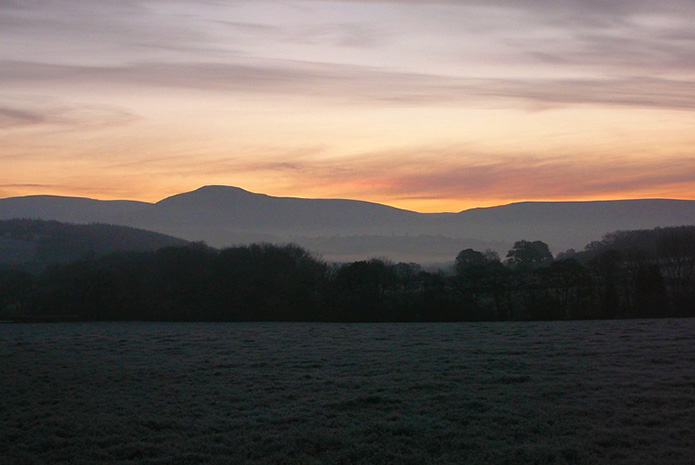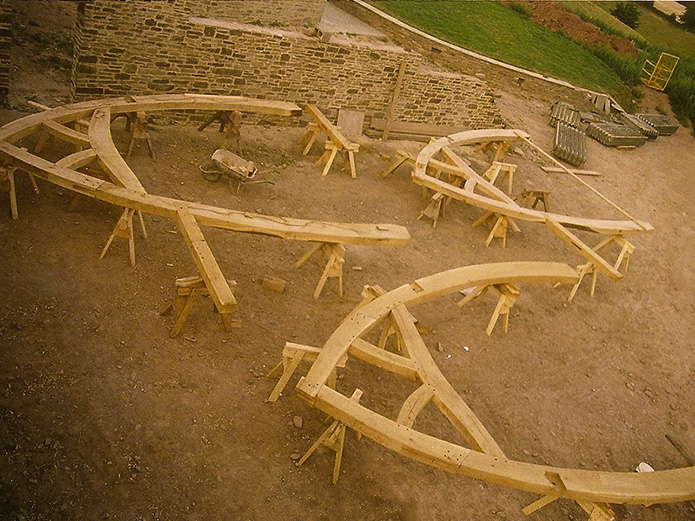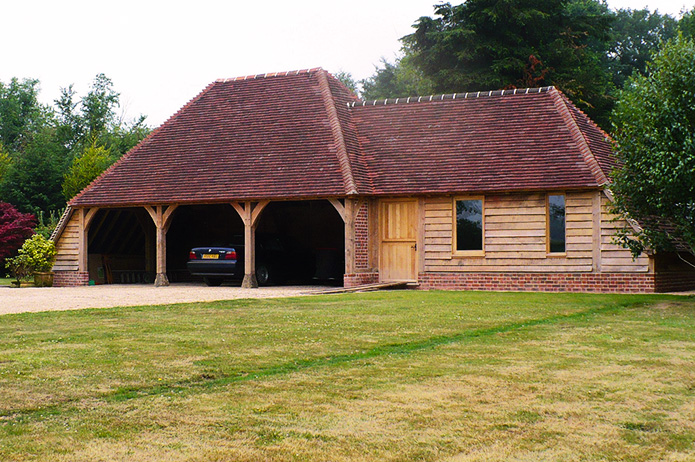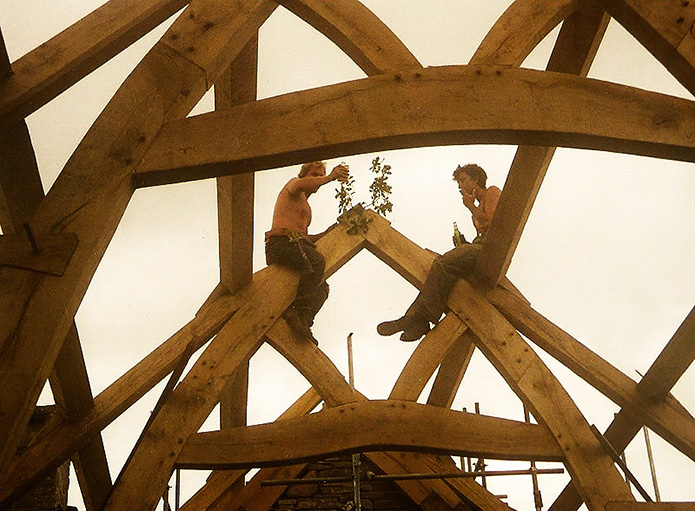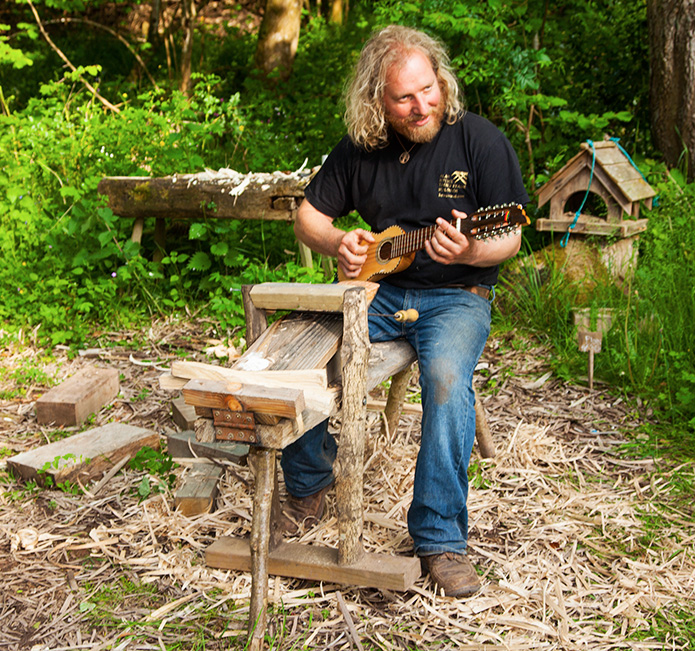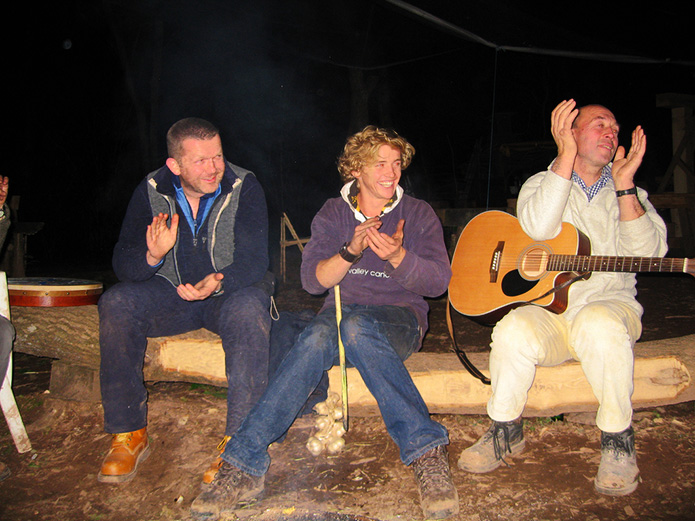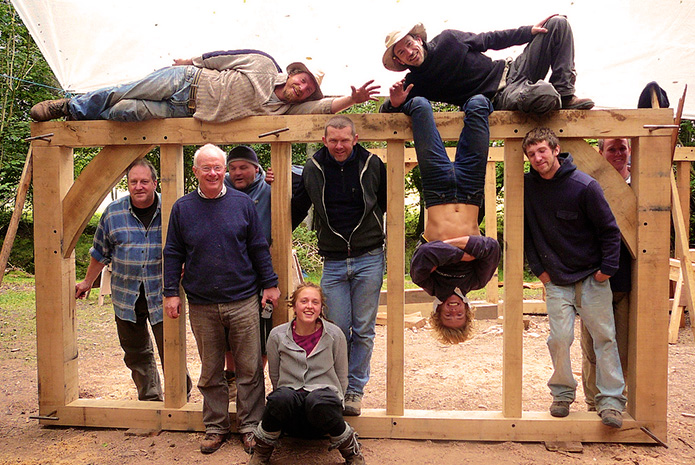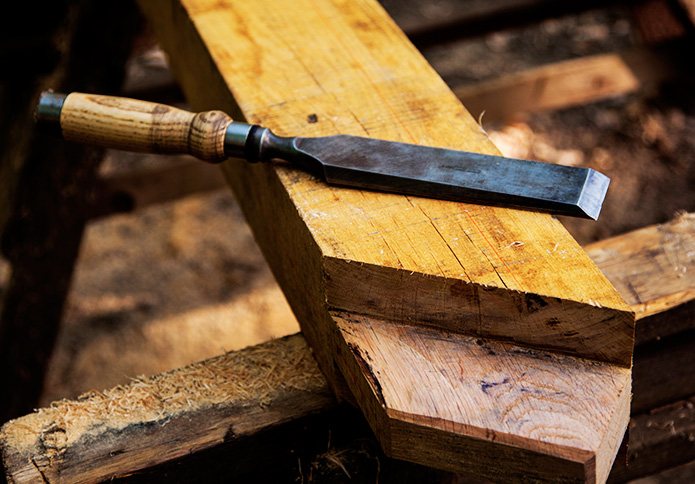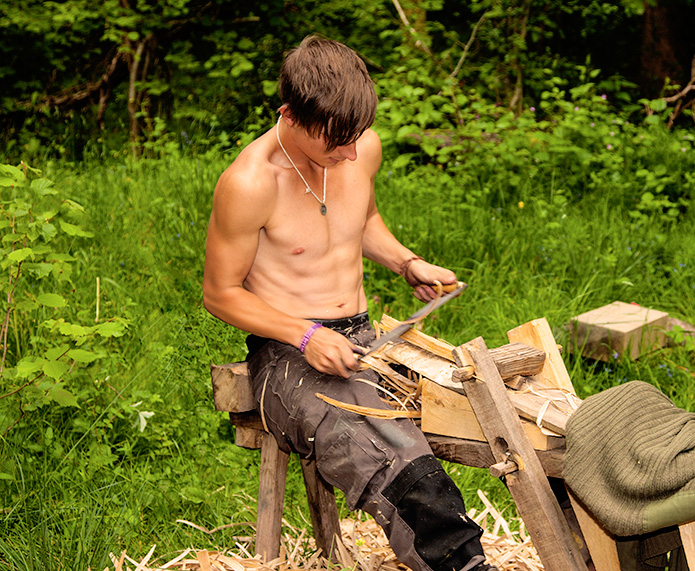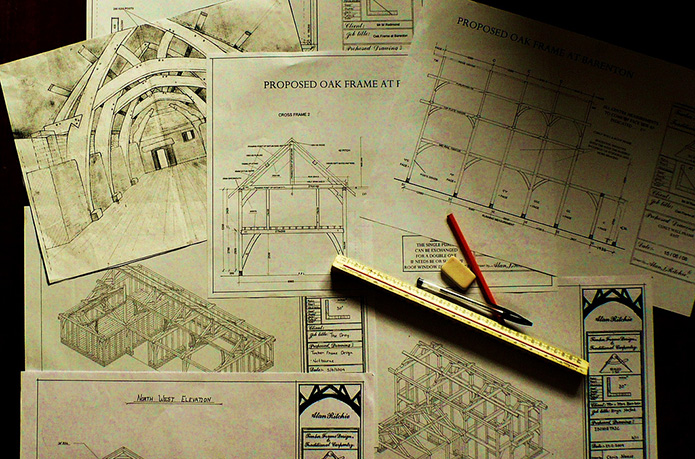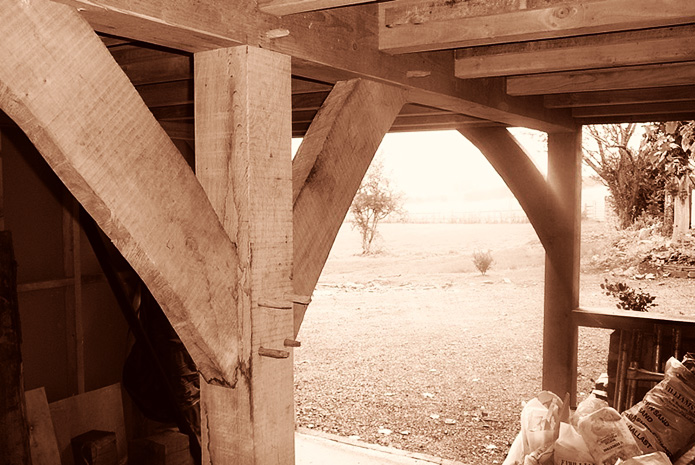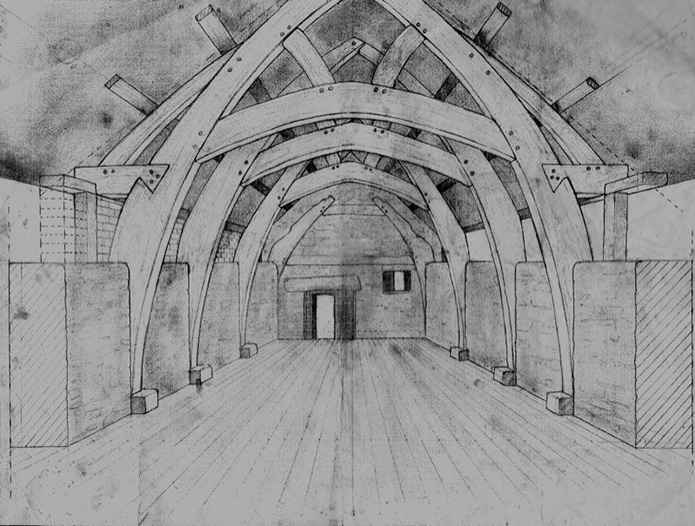
Image courtesy of Alan Ritchie / Hewnwood
I wanted to feature our good friend and traditional timber frame craftsman Alan Ritchie, founder of the timber framing company Hewnwood, as I have been lucky enough to have had first-hand experience of seeing Alan in action, having spent time at one of his workshops on a beginner framing course, and know what fantastic work he produces and wanted to showcase this master craftsman with readers. Timber framing sits on the ‘cross-piece’ of craft, design and engineering, and it’s a fascinating subject area with a rich heritage in Britain. As you’ll read below, Alan discusses why traditional timber framing is becoming increasingly popular, how the techniques haven’t changed much since the Middle Ages, his working environment and his thoughts on the future of this special craft. We hope this gives you a small insight into his craft, and an opportunity to view some great examples of the work he so skilfully produces.
ABOUT ALAN RITCHIE
Based in the Brecon Beacons countryside, straddling the English/Welsh border, Alan Ritchie runs Hewnwood, a workshop dedicated to the traditional art of timber framing. Having grown up in Devon, and learning his craft on major restoration and new build projects throughout Europe, Alan decided to create Hewnwood 10 years ago to focus on the craft of designing and creating unique fully jointed frames using large section timbers to create buildings full of character and exceptional beauty. Alan periodically runs a series of week-long courses for those interested in timber framing to gain insights into the craft for novices or an opportunity to develop their skills for more advanced students.
Firstly, why do you think traditional timber framing, building a structure completely by hand, is still relevant today?
There has been a huge resurgence in oak framing over the last few decades with the trend towards creating more sustainable buildings which have structural beauty where the main frame has been made of oak; it’s a tried and tested heritage that has proved itself over centuries. This has paved the way for a new generation of carpenters that are looking at the past to create the future. The nature of this craft and the space needed to make the frames as well as the raw material and saw mills to process is ideally suited to rural areas boosting employment in these threatened economies which have generally struggled in the downturn.
How did you become involved in the craft of traditional timber framing, was it something you always wanted to do?
When I was an apprentice carpenter 30 years ago I had next to no knowledge of timber frame buildings; the carpentry industry that I was involved in, doing first and second fix, seemed more about speed rather than quality. After my apprenticeship I jobbed around and got quite a lot of experience in different aspects of carpentry. One firm that I worked with got a contract to do some work at the Lambeth Palace in London and this was my first experience of working with traditional carpentry. I was fascinated with the standard of craftsmanship needed for this work and I spent a lot of time studying the work that carpenters had done in the past, their joints, and how the vast majority of these joints are still being used today, but why a few didn’t, and I like the fact that it’s still possible to make changes to their work, but the overall integrity is still the same. After Lambeth Palace I decided I would do my own journeyman training travelling throughout Europe working on different self-build projects and alongside heritage craftsmen and timber frame companies to gain experience.
It’s hard to put into words why I enjoy timber framing so much, but it’s so diverse: there’s the design aspect, looking at the concept of structure and how to make it work; there’s the skill of marking out the wood, the finesse required to ensure the joints can be cut so all the pieces of wood fit together accurately; and there’s the physical aspect, to actually cut the joints and assemble the structure. In the past, whole generations of families would have worked with wood, and the skills would have been passed down from father to son, and it was just ‘in their blood’. People talk about having a ‘feel’ for something, and that’s what I have with working with wood, and it’s definitely in my blood.
Is it true that you still use the same framing methods and techniques as a thousand years ago when the great cathedrals of Britain were being built?
A lot of the same principle techniques of marking and scribing the timbers would be very similar to what the carpenters of the Middle Ages would have done, at the time when they were building their awe inspiring halls and cathedrals. We can base a lot of our designs on historic carpentry such as cruck frames, arch brace trusses and hammer beam roof construction that were used at that time. We still use a lot of hand tools such as carpenter’s axe, chisel, adze, drawknife and hand saws as they did in the Middle Ages.
Most timber framers today would use an electric chain morticer, a circular saw and electric drill as hand-held labour saving devices to cut the mortice and tenons but the joinery is mainly unaltered and the framing methods are primarily the same.
How do you select the wood to be used within the frame?
We use ‘green oak’ for its workability and its cheaper cost. It’s called ‘green’ because it’s freshly cut, not because of it’s colour; when it’s first cut it has a golden yellow colour which softens and pales indoors, but when exposed to the elements outside it turns a beautiful silver-grey colour. Green oak is easier to use than air dried timber which becomes very hard, and because it’s been left and cared for outside for a long period, it is more expensive to buy, although we do use air dried timber for added stability where necessary. The frames and joints are designed to allow for the shrinkage. The twisting and movement that occurs are quite often what give these buildings their unique charm.
Each piece of timber will have a certain amount of acceptable bow and twist in it, and it’s the skill of the framer to ‘read’ each piece of wood and orientate it within the frame to make use of its natural strengths. Each part of the frame is then hand scribed to create the best possible fit for every joint. All the braces and curves for the frame are cut from naturally curved timbers, and we personally select the specific timber to be used at the local saw mill to check for the curve of the grain to utilise the strength of the natural wood, as it would be significantly weakened if it was cut it across the grain.
Another extremely important part of the frame is the pegs used in the joints. We make all of pegs by hand in order to work with the grain of the wood. Again this is to make use of the natural strength of the wood as a machine made dowel would be likely to snap or require hidden steel support. When we make holes in the tenon and mortice for the pegs we offset them so that when the peg is driven home the peg acts as a wedge drawing the joint tightly together. We have to taper the pegs, which allows the peg to be driven in further when necessary due to the natural amount of shrinkage that occurs in the timbers over time, maintaining a snugly fitting joint.
Some timber frame companies use a large amount of automation, such as CNC machines, to cut their frames, however they’re only able to take straight and square timbers, and because machines can’t allow for the idiosyncrasies of a natural material such as wood, they have a tendency to cut inaccurate joints. I firmly believe the best frames come from working with nature to fully utilise the inherent strength and beauty of the wood within the frame.
Once we’ve got the frame erected, some of the timbers may have got slightly blackened with rainwater. We paint a water and oxalic acid mix carefully onto the timbers, leave for a couple of hours and then power hose the timber with water, which removes the stained areas, leaving a clean, yellow colour.
How does building a structure from green oak compare to modern construction materials, and are they designed to last generations?
Oak frames last for centuries as the nature of the timber is strong and resilient due to it being a slow growing hardwood with a high concentration of natural tannin acting as a preservative. If kept dry the oak can last indefinitely! This, in conjunction with a strong frame design and the correct orientation of the timber, give a building that can have many uses over generations. An oak frame also has the potential of being disassembled and reassembled at an alternative location, which is something that I have actually done with one particular aisled barn. It’s inspiring to think that some of the buildings built by craftsman in the Middle Ages are still standing, still giving that feeling of enormous strength and steadfastness. Superb design, joinery and careful selection of timbers were at the heart of their craft. When you break it down, it’s basically wood tightly fitted into wood, held together by wooden pins; a simple formula that’s been proved to stand the test of time.
Can you explain your workshop; I understand it’s set amongst open woodland?
We chose to run our workshop out in a broadleaf woodland where we have made a clearing amongst the leafy canopy and have created shelters to work under. This also lends itself to the courses we run, giving an idyllic setting, without the everyday distractions around. I find this helps people relax and makes it an easier place to learn. We eat as a group, share stories and music around the campfire and even have some sport in the way of axe throwing. This all helps to create a close group and a good working atmosphere.
What is it like living and working in rural Wales?
Living in Wales for me was a choice I made 10 years ago. I came for the open spaces and a less crowded feel. I haven’t regretted a single day. I have made many friends locally, and I work closely with the Tywi Centre in Llandeilo [a heritage and rural skills training provider] as a placement provider to train heritage carpenters in Wales. We source our timber as locally as possible from saw millers close by and use a local haulier.
What type of projects do you most like to get involved in?
There are various approaches to frame construction such as the British method which typically makes use of the natural curves in timbers, and the American ‘post and beam’ style, which tends to have straighter lines. I choose to create frames using the British method, so making use of natural curves.
Each project I do is individual and has its own character, whether that’s a full frame house, a barn, garage, outbuilding, conservatory, porch or restoration work but it’s always nice to have a sizeable job, and I do like the big bends of the cruck frame construction.
What is a ‘topping out’ ceremony?
When we complete a frame we top it out, which is a blessing of goodwill for the frame. I think it can be traced back to the ancient Scandinavians – as part of a religious ceremony they placed a tree on top of a new building to appease the tree-dwelling spirits of their ancestors who’d been displaced. I think it came over to Britain with the Vikings. Topping out involves placing a sprig of oak at a high point of the frame, and then pouring some whiskey over the sprig letting it run onto the frame and then saying a few chosen words. Sometimes a bit of celebration might follow with music and food.
You have been involved in the folk music for a long time; does your love of music inter-twine with your craft of working with wood?
I have been involved with folk music as long as I have been involved in woodwork, so I have combined these things in the way of making my own stringed instruments, such as the mandolin, mandola, cittern, bouzouki and guitar. There was historically a strong connection between folk music and traditional trades and crafts in the countryside, and most of the songs were, and are, about everyday people – workers such as woodsmen, blacksmiths, carpenters, tanners, soldiers and people of the land.
Any manual work had songs associated with it, as there weren’t any radios or other distractions, so workers created ‘call and response’ songs (a bit like sea shanties). Someone would call out and there would be the response from others. They were designed to keep spirits going whilst doing laborious tasks. We still actually break out with call and response songs at work today.
You will quite often hear a tune or song in practice at break times and the occasional musical friend dropping in for a tune. We even have a lot of people attending our courses that bring their musical instruments with them. We had some members of the Welsh language folk band ‘Fernhill’ join us a few weeks ago for one of our beginner framing courses – I agreed to teach them the basics in timber framing, and they agreed to teach me new Welsh songs, which we would practice during breaks. I was also recently joined by someone from Bolivia who attended a framing course and he brought his charango with him all the way from South America as he’d heard that we like to break out into songs.
Interestingly, the Welsh folk scene is going through a revival at the moment, and it’s where Ireland was 50/60 years ago, but growing at a pace, and it’s great to be part of this revival, playing with, and listening to, pipes, hurdy gurdy, pipcorns, fiddles etc. Historically, folk music was a verbal tradition, and not a lot of it was written down, and fiddle music was even banned by the Church in years gone by, but we’re gradually unearthing new songs and fathoming out how the songs would have been arranged.
What advice could you provide for anyone looking to pursue a career in timber framing?
It takes about 3 years in total to complete an apprenticeship. There aren’t really any formal college courses in timber framing, like there are with other traditional crafts, so this makes things tougher for people starting out – it’s one of the reasons why we started running courses here. I think perseverance is key. You really need to gain as much experience as possible, and so this means you have to make yourself available to work on interesting projects to gain experience, so you might have to travel around for the first few years.
It’s difficult to gain all your experience with one firm, as they may be working on a large project where they may need additional help for 2 or 3 months and it’s possible to gain a lot of experience, but when that project’s complete, they might not have need for additional help for a while, and that’s why it’ll be necessary to get experience elsewhere. During this time, don’t expect too much financial reward, and it will be job satisfaction and experience that you will likely be rewarded with.
Of course, the larger framing companies are doing more projects, but the downside for the apprentice, is that a lot of them use CNC machines, which are large, expensive machines which plane the wood to size and cut the mortice and tenon joints automatically based on Computer Aided Design drawings, so it’s not possible to gain experience in marking and scribing, learning about the orientation of timber, the camber (the strength in bends of wood), or actually cutting the joints by hand. They will typically have a team of CAD designers, and one person feeding wood into a machine, and then a team of people who just erect the structure, so an apprentice framer working for one of these companies is unlikely to gain a broad range of experience.
There is a National Vocational Qualification in ‘Post and Beam’ (another term to describe timber framing) which might be able to provide a placement with a timber framing company, and we currently have two trainees doing placement work with us at the moment from the Tywi Centre in Llandeilo, which is a heritage craft training centre that supports people wanting to develop a career in traditional crafts in Wales. I would have thought there would be equivalents in the rest of the UK.
My final piece of advice is to make sure you are honest with yourself that you have the right temperament for the craft. Timber framing requires the ability to think three dimensionally and good spatial awareness is necessary. Being a team player is key, as you need to work on teams with other people, and attention to detail is essential.
How do you see the future for traditional timber framing and do you think any of your children will continue with the tradition?
The demand for timber framed houses is strong, and fortunately we’ve always been busy. My eldest son Connor is following the tradition and I have trained a small team who work with me, and many more who have taken their skills across the country and those who have taken their skills abroad so now you can find some great traditional carpenters with knowledge of traditional British oak framing in Australia and Canada. Looking ahead, I think the large framing companies that manufacture their frames from CNC machines will erode the traditional craftsmen’s skills.
Clients tend to fit into two categories; people who want a timber framed house and have researched the craft and want it to be made completely by hand, and people who just want a house to ‘look’ right, and aren’t really knowledgeable about how it’s made, the orientation and camber of wood etc. Unfortunately, almost all timber framing companies describe themselves as producing ‘hand crafted’ timber frames, but there really is a huge difference in how they’re actually made, and it can be terribly confusing for buyers. Virtually all the demand for our frames is from people that have researched the craft and want their frames made in the traditional way.
The best advice I can give to anyone who wants a traditional oak framed house is to ask the timber frame company directly how they make their frames, rather than rely purely on a company’s website or brochure, which imply that they’re all made by hand.
The make-up of the workforce will change over the years if CNC machined frames become more popular, and there will be more CAD designers and less craftsmen. For instance, an expensive CNC machine needs to produce one frame per week to pay for itself (and the CAD design team and frame erectors), which is a lot of frames over the course of a year. Whereas, one frame for my company could keep eight skilled craftsmen in work for two or three months!
I am often approached by people starting out in their careers asking for the opportunity to gain experience here at Hewnwood, and even from people that have worked for the large CNC timber manufacturers but can’t get enough experience, so the future looks bright in terms of the demand by people who want to develop a career in traditional oak framing, but I just hope that there is the demand for their skilled work in the future, because it would be a real shame if the craft became monopolised by machines.
Thanks to Alan Ritchie for taking time out of his busy schedule to answer our questions. To learn more about timber framing, Alan Ritchie runs one week framing courses periodically through the year for complete beginners and advanced framers alike, and from personal experience they’re great fun and I wholeheartedly recommend them! For more information on courses or if you’re considering a project, please visit Alan’s website by clicking the link below:

